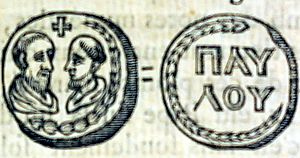Pope Paul I facts for kids
Quick facts for kids Pope Saint Paul I |
|
|---|---|
| Bishop of Rome | |
| Church | Catholic Church |
| Papacy began | 29 May 757 |
| Papacy ended | 28 June 767 |
| Predecessor | Stephen II |
| Successor | Stephen III |
| Personal details | |
| Born | Rome, Exarchate of Ravenna, Byzantine Empire |
| Died | 28 June 767 Rome, Papal States |
| Other Popes named Paul | |
Pope Paul I (Latin: Paulus I; 700 – 28 June 767) was the leader of the Catholic Church in Rome and ruler of the Papal States from May 29, 757, until his death. Before becoming pope, he worked as a deacon in Rome. His brother, Pope Stephen II, often sent him to talk with the Lombard kings.
Becoming Pope: Paul's Journey
Paul was from a noble family in Rome called the Orsini. He and his brother, Stephen, both studied to become priests at the Lateran Palace. Stephen became pope in 752. After Stephen passed away in 757, people had to choose a new pope. Many wanted Paul to continue his brother's plans, so they chose him to be the next pope.
Pope Paul's Time as Leader
During Pope Paul I's time as leader, his main focus was on his relationships with the Frankish kings and the Lombard kings, as well as the Eastern Roman emperor. He wanted to keep a strong friendship with the Frankish kingdom. This was important because the Lombard king, Desiderius, was a threat.
The Lombards controlled several cities that the Pope claimed, like Imola, Osimo, Bologna, and Ancona. In 758, they also took over the areas of Spoleto and Benevento.
King Desiderius visited Rome and made Pope Paul write to the Frankish king, Pepin the Short, asking him to agree to the Lombard claims. Desiderius promised to give back Imola if the Pope could convince Pepin to return Lombard people held by the Franks. Pope Paul agreed and sent the letter. Pepin decided it was best to stay on good terms with Desiderius.
Later, Pepin did help the Pope and acted as a mediator between Rome and the Lombards. In 765, the Pope's rights were given back in the areas of Benevento and Tuscany, and partly in Spoleto.
Meanwhile, the relationship with the Eastern Roman Empire became worse. Several times, especially in 759, Pope Paul worried that the emperor might send an army to Rome. He was always afraid that the Eastern Roman Empire would try to turn the Franks against him and in favor of the Lombards. This attempt was made, but Pepin stuck to his original plan for Italy.
Pope Paul I passed away in Rome on June 28, 767.
See also
 In Spanish: Paulo I para niños
In Spanish: Paulo I para niños


